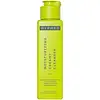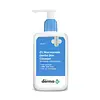What's inside
What's inside
 Key Ingredients
Key Ingredients

 Benefits
Benefits

 Concerns
Concerns

 Ingredients Side-by-side
Ingredients Side-by-side

Water
Skin ConditioningCocamidopropyl Betaine
CleansingCaprylyl Glucoside
CleansingGlycerin
HumectantSodium Methyl Cocoyl Taurate
CleansingAvena Sativa Kernel Extract
AbrasiveSodium Cocoyl Isethionate
CleansingSodium Polyglutamate Crosspolymer
Emulsion StabilisingGlycol Distearate
EmollientCeramide EOP
Skin ConditioningCeramide Ns
Skin ConditioningCeramide NP
Skin ConditioningCeramide As
Skin ConditioningCeramide AP
Skin ConditioningLaminaria Digitata Extract
Skin ProtectingLecithin
EmollientSaccharide Isomerate
HumectantTrehalose
HumectantPEG-150 Distearate
EmulsifyingAcrylates Copolymer
Styrene/Acrylates Copolymer
Xanthan Gum
EmulsifyingSodium Lauroyl Lactylate
EmulsifyingCapryloyl Glycine
CleansingUndecylenoyl Glycine
CleansingCetyl-Pg Hydroxyethyl Palmitamide
Skin ConditioningCitric Acid
BufferingSodium Citrate
BufferingC12-15 Alkyl Benzoate
AntimicrobialTitanium Dioxide
Cosmetic ColorantStearic Acid
CleansingAluminum Hydroxide
EmollientPolyglyceryl-3 Diisostearate
EmulsifyingPhenoxyethanol
PreservativeBenzoic Acid
MaskingWater, Cocamidopropyl Betaine, Caprylyl Glucoside, Glycerin, Sodium Methyl Cocoyl Taurate, Avena Sativa Kernel Extract, Sodium Cocoyl Isethionate, Sodium Polyglutamate Crosspolymer, Glycol Distearate, Ceramide EOP, Ceramide Ns, Ceramide NP, Ceramide As, Ceramide AP, Laminaria Digitata Extract, Lecithin, Saccharide Isomerate, Trehalose, PEG-150 Distearate, Acrylates Copolymer, Styrene/Acrylates Copolymer, Xanthan Gum, Sodium Lauroyl Lactylate, Capryloyl Glycine, Undecylenoyl Glycine, Cetyl-Pg Hydroxyethyl Palmitamide, Citric Acid, Sodium Citrate, C12-15 Alkyl Benzoate, Titanium Dioxide, Stearic Acid, Aluminum Hydroxide, Polyglyceryl-3 Diisostearate, Phenoxyethanol, Benzoic Acid
Water
Skin ConditioningCetearyl Alcohol
EmollientGlycerin
HumectantNiacinamide
SmoothingSodium Cocoyl Isethionate
CleansingPhenoxyethanol
PreservativeEthylhexylglycerin
Skin ConditioningCocamidopropyl Betaine
CleansingXanthan Gum
EmulsifyingCicada Extract
AntioxidantCetyl Alcohol
EmollientCarbomer
Emulsion StabilisingSaccharide Isomerate
HumectantSodium Gluconate
Skin ConditioningCeramide AP
Skin ConditioningAvena Sativa Kernel Extract
AbrasiveTocopherol
AntioxidantCitric Acid
BufferingSodium Citrate
BufferingWater, Cetearyl Alcohol, Glycerin, Niacinamide, Sodium Cocoyl Isethionate, Phenoxyethanol, Ethylhexylglycerin, Cocamidopropyl Betaine, Xanthan Gum, Cicada Extract, Cetyl Alcohol, Carbomer, Saccharide Isomerate, Sodium Gluconate, Ceramide AP, Avena Sativa Kernel Extract, Tocopherol, Citric Acid, Sodium Citrate
Ingredients Explained
These ingredients are found in both products.
Ingredients higher up in an ingredient list are typically present in a larger amount.
Avena Sativa Kernel Extract is is derived from colloidal oatmeal. Besides being a healthy breakfast, oats have many benefits in skincare too.
This ingredient helps sooth, hydrate, and protect the skin. The starches in colloidal oatmeal are able to bind water, keeping the skin hydrated.
The cellulose and fiber in colloidal oatmeal help reduce inflammation. This can also help the skin feel softer.
Colloidal Oatmeal is also an antioxidant. Antioxidants protect our skin from free-radical damage.
Oatmeal also contains beneficial compounds:
This ingredient is created by mixing grounded oatmeal and a liquid base.
Learn more about Avena Sativa Kernel ExtractCeramide AP is formally known as Ceramide 6.
Ceramides are intercellular lipids naturally found in our skin that bonds dead skin cells together to create a barrier. Having a strong skin barrier leads to more firm and hydrated skin.
They are known for their ability to hold water and thus are a great ingredient for dry skin. By bolstering the skin ceramides act as a barrier against irritating ingredients. This can help with inflammation as well.
If you would like to eat ceramides, sweet potatoes contain a small amount.
Read more about other common types of ceramides here:
Ceramide NP
Ceramide EOP
Citric Acid is an alpha hydroxy acid (AHA) naturally found in citrus fruits like oranges, lemons, and limes.
Like other AHAs, citric acid can exfoliate skin by breaking down the bonds that hold dead skin cells together. This helps reveal smoother and brighter skin underneath.
However, this exfoliating effect only happens at high concentrations (20%) which can be hard to find in cosmetic products.
Due to this, citric acid is usually included in small amounts as a pH adjuster. This helps keep products slightly more acidic and compatible with skin's natural pH.
In skincare formulas, citric acid can:
While it can provide some skin benefits, research shows lactic acid and glycolic acid are generally more effective and less irritating exfoliants.
Most citric acid used in skincare today is made by fermenting sugars (usually from molasses). This synthetic version is identical to the natural citrus form but easier to stabilize and use in formulations.
Read more about some other popular AHA's here:
Learn more about Citric AcidCocamidopropyl Betaine is a fatty acid created by mixing similar compounds in coconut oil and dimethylaminopropylamine, a compound with two amino groups.
This ingredient is a surfactant and cleanser. It helps gather the dirt, pollutants, and other impurities in your skin to be washed away. It also helps thicken a product and make the texture more creamy.
Being created from coconut oil means Cocamidopropyl Betaine is hydrating for the skin.
While Cocamidopropyl Betaine was believed to be an allergen, a study from 2012 disproved this. It found two compounds in unpure Cocamidopropyl Betaine to be the irritants: aminoamide and 3-dimethylaminopropylamine. High-grade and pure Cocamidopropyl Betaine did not induce allergic reactions during this study.
Learn more about Cocamidopropyl BetaineGlycerin is already naturally found in your skin. It helps moisturize and protect your skin.
A study from 2016 found glycerin to be more effective as a humectant than AHAs and hyaluronic acid.
As a humectant, it helps the skin stay hydrated by pulling moisture to your skin. The low molecular weight of glycerin allows it to pull moisture into the deeper layers of your skin.
Hydrated skin improves your skin barrier; Your skin barrier helps protect against irritants and bacteria.
Glycerin has also been found to have antimicrobial and antiviral properties. Due to these properties, glycerin is often used in wound and burn treatments.
In cosmetics, glycerin is usually derived from plants such as soybean or palm. However, it can also be sourced from animals, such as tallow or animal fat.
This ingredient is organic, colorless, odorless, and non-toxic.
Glycerin is the name for this ingredient in American English. British English uses Glycerol/Glycerine.
Learn more about GlycerinPhenoxyethanol is a preservative that has germicide, antimicrobial, and aromatic properties. Studies show that phenoxyethanol can prevent microbial growth. By itself, it has a scent that is similar to that of a rose.
It's often used in formulations along with Caprylyl Glycol to preserve the shelf life of products.
Saccharide Isomerate comes from sugars found in corn. It is a skin hydrator.
The structure of this ingredient can be altered to be more similar to the carbohydrates found in our skin. This ability to mimic our skin gives it hydrating properties.
Specifically, saccharide Isomerate is a humectant. Humectants draw moisture from the air to our skin.
Research shows Saccharide Isomerate to be an effective moisturizer.
Learn more about Saccharide IsomerateSodium Citrate is the sodium salts of citric acid. In skincare, it is used to alter pH levels and acts as a preservative.
Its main functions are to maintain the pH of a product and neutralize metal ions.
The acidity of our skin is maintained by our glands and skin biome; normal pH level of skin is slightly acidic (~4.75-5.5).
Being slightly acidic allows our skin to create an "acid mantle". This acid mantle is a thin barrier that protects our skin from bacteria and contaminants.
Learn more about Sodium CitrateSodium cocoyl isethionate is a natural ingredient from coconut oil. It is an ultra gentle cleanser that gives a nice foam without drying the skin or impacting the skin barrier.
The amount of foam created depends on the amount of sodium cocoyl isethionate used in the product.
This ingredient also helps improve the spreadability of a product.
Learn more about Sodium Cocoyl IsethionateWater. It's the most common cosmetic ingredient of all. You'll usually see it at the top of ingredient lists, meaning that it makes up the largest part of the product.
So why is it so popular? Water most often acts as a solvent - this means that it helps dissolve other ingredients into the formulation.
You'll also recognize water as that liquid we all need to stay alive. If you see this, drink a glass of water. Stay hydrated!
Learn more about WaterXanthan gum is used as a stabilizer and thickener within cosmetic products. It helps give products a sticky, thick feeling - preventing them from being too runny.
On the technical side of things, xanthan gum is a polysaccharide - a combination consisting of multiple sugar molecules bonded together.
Xanthan gum is a pretty common and great ingredient. It is a natural, non-toxic, non-irritating ingredient that is also commonly used in food products.
Learn more about Xanthan Gum